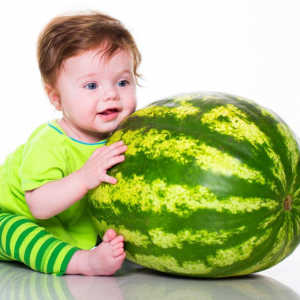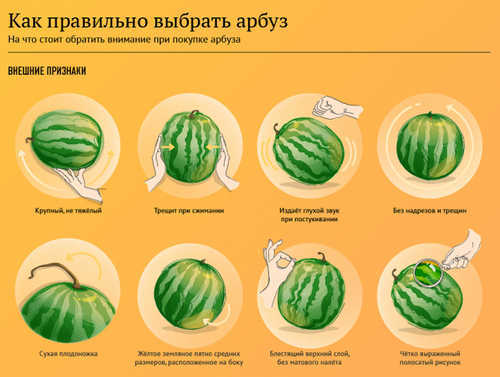Watermelon is one of the most popular and beloved berries, which is incredibly moist, with a pleasant, light taste and an exceptional aroma. Summer watermelon you can buy on almost every corner, so there is nothing surprising in the fact that he is a guest in almost every home in our country.
Danae berry quenches thirst and is a source of masses of nutrients, but in recent times there has been talk about the dangers of watermelon for serious violations of the rules of its cultivation.
So before you introduce this product in the children’s diet, you should understand how safe watermelon for the health of the child, as well as when and how to begin to acquaint the kid with the biggest representative of the berry family.
Benefits of watermelon for the child’s body?
Watermelon contains a lot of useful minerals necessary for a growing child’s body. Approximately 90% of watermelon is water, so it quenches your thirst. In addition, having a pronounced diuretic effect, this product helps rid the body of toxins and other harmful elements.
To the beneficial properties of watermelon include:
- The high content of lycopene, a substance with antioxidant properties and playing an important role in the development of the cardiovascular system of the child. Reduces the risk of developing asthma and lung cancer, gastrointestinal (GI) tract, breast and prostate.
- A large amount of fiber, which is helpful for kids with irregular stool. Fiber helps remove toxins from the child’s body, to maintain healthy skin and prevent the occurrence of cancer.
- The presence of huge amounts of citrulline. This is an alpha amino acid, which promotes the proper functioning of the cardiovascular system.
- Low calorie, which is important for kids who are overweight. Despite the fact that the caloric content of watermelon is only 27 Kcal per 100 g of product, it not only quenches thirst but also hunger.
- High content of beta-carotene, which helps to cope with high physical and emotional stress. Besides helping to combat stress, beta-carotene has beneficial effects on the immune system, which is very important for the child’s body.

In addition to the above substances, the watermelon also delivers in the child’s body with such useful elements as:
Interestingly, to get daily norm of vitamins C, B1, B3 and folic acid, eat just 150 grams of juicy berries per day.

All these useful properties of watermelon correspond to reality only if the process of growing berries has not been used any chemicals to accelerate the growth of, or to obtain watermelons in larger sizes. Otherwise, due to the large amount of nitrates familiarizing the child with watermelon can result in deterioration of the transport properties of blood, oxygen starvation, that for a growing child’s body is dangerous.
Contraindications to the use of watermelon
Unfortunately, such useful berries as watermelon, you can eat not all and not always.
At what age can you give watermelon to children? Quantitative norm
The opinions of experts on this subject are very divergent. Some doctors claim that by teaching children this berry is not before the age of five.According to foreign experts, to introduce a quality product in the children’s menu starting from 8-10 months.

But the majority of representatives of the national Pediatrics believes that to age of children watermelon feed is not necessary, and that the optimal age for Dating crumbs with this product is 1.5-2 years. This view is substantiated by the fact that the digestive tract of the child at an earlier age are not yet able to fully digest the watermelon fiber.
Given the fact that at the present time to get a quality “clean” product is difficult, and not everyone has the opportunity to grow the berries on their own, many doctors do not recommend to offer watermelon to a child younger than 2 years (especially infants). Should be a very responsible approach to the selection of berries, as a growing body is not able to withstand the effects of harmful additives such as nitrates and toxins.
Watermelon is a seasonal fruit, so no need to give it to the child until August, or rather its middle. In addition, children should be sugar pulp, located in the center of the watermelon, because nitrates accumulate always closer to the skin.
At the first acquaintance of the kid with a watermelon need to offer him one teaspoon of the pulp, of course, following that it was seedless. Then a few days you should observe the child and make sure there is no allergic reaction.
Symptoms of an allergic reaction:
- redness or rashes on the skin;
- itching;
- edema of the mucosa;
- increased tears and/or runny nose;
- vomiting;
- gastrointestinal disorders, diarrhea.
In the absence of such allergic reactions, it is possible to increase the proposed dose of the watermelon, however, be aware that each age has its limitations.
Daily intake of the berries for a child:
- 1-2 years – up to 50 g.
- 2-3 years – 100
- With 3 to 6 years – 150 g
In compliance with the specified quantitative standards and the availability of high quality product, the child will not only get pleasure from eating the delicious berries, but also a lot of “Goodies” for a growing body.
The basic rules for choosing and eating watermelon
- It is not recommended to buy watermelons near the road with cars or in a precarious trays. First, it is difficult to observe whether the terms and conditions of storage, and secondly, bocheva products quickly absorbs heavy metals, which abound in the exhaust gases. Watermelons should be sold in specially designated areas, under a canopy, and lie down in a special tray on the distance from the ground at least 20 cm.
- Early watermelons have no place in the house where there are children. Buy a watermelon for the child can not earlier than mid-August. However, even “late” berries may contain harmful additives. There are some obvious signs that a watermelon is “nitrate”, namely:
- fiber running from the core to the crust, not white and soft, and yellowish solid;
- on the cut surface “nitrate” berries smooth and glossy, and a good watermelon it should be with the grains;
- high nitrates can also speak a uniform bright red color berries. The flesh of “clean” watermelon has a non-uniform color.
- In no case do not buy a watermelon with a damaged cork, because bacteria from soil, dust and other contaminants can easily penetrate into the flesh, which for them is a favorable environment for active reproduction.
- Never ask the seller to cut a watermelon (to test its ripeness) and not buy half or part of the berry, even if it is well packaged in plastic wrap. Otherwise you risk to put in the body of his household Salmonella or E. coli.
- Before cutting the watermelon house, it should be thoroughly washed with soap and brush.
- Children are encouraged to separate the pulp that is located closer to the middle, and carefully choose all the seeds.
The dangers of watermelon for children.

Child poisoning in the summer – unfortunately, a common occurrence. And often the “culprit” for such a situation serves everyone’s favorite treat – watermelon. The seriousness of this problem lies in the fact that the process of poisoning in children is very difficult due to the underdeveloped digestive tract is not fully developed detoxification mechanisms and because of the small amount of blood in the body of the child.
What is the danger of early watermelons for a child?
In most cases, children bring harm to it early and large water-melons, in the process of growing which use nitrogen nitrate fertilizers. Early melons, as a rule, contain very high levels of nitrates, since the producers are trying to speed up the process of fruit ripening, as well as to their large mass.
To check the concentration of nitrates in watermelon you can use a portable device – nitrate sensor. A valid norm to the presence of nitrates in the berry is considered to be 60 mg per 1 kg of product. Everything above will bring harm to health.
So, nitrates, trapped in a human body:
- have a negative impact on the mucous membranes of the gastrointestinal tract, causing diarrhea, vomiting and nausea;
- intensify the process of accumulation of heavy metals in the kidneys and liver;
- slow down the process of absorption of nutrients, particularly magnesium and vitamin C (decreasing absorption almost 3 times).
In addition, getting in the gastrointestinal tract under the influence of local microflora, nitrates are converted to thermally less stable salts – nitrites, which in turn will convert the hemoglobin, oxidizing the iron in methemoglobin, unable to carry oxygen. As a result, violated the most important function of blood transport, which leads to oxygen starvation of tissues, and for a growing body such failures are extremely dangerous.
The presence of nitrates in watermelon is not the only reason why the child may experience health problems.
So, no less frequent cases of poisoning in children when:
- the pulp of the berries is used by the baby in large amounts significantly exceeding the daily the age norm;
- the watermelon before eating was carelessly washed, so that little ones have intestinal disorders;
- eating unripe berries.
As a rule, the symptoms of poisoning watermelon may occur in children within two days.
The following are the most common signs of poisoning:
- Diarrhea.
- Nausea and vomiting.
- Dizziness.
- Shortness of breath.
- Drowsy and sluggish state of the child.
If after eating the watermelon was manifested at least one of these symptoms, should immediately seek medical help, because self-medication in childhood poisoning is unacceptable.




First of all I would like to say wonderful blog!
I had a quick question in which I’d like to ask if you do not mind. I was curious to find out how you center yourself and clear your mind before writing. I have had a difficult time clearing my
mind in getting my thoughts out there. I truly do take pleasure in writing but it just seems like the first 10 to 15 minutes are generally lost just trying to figure out how to begin. Any ideas or tips? Thanks!